|
Discover
the hidden treasures of Drake Bay, Costa Rica with Tracie
"The Bug Lady" .

Home

Tour
Basics

Meet
the Bug Lady

Tales
from the Edge

Media

Reservations

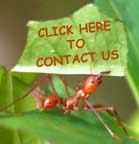

Facts about Drake Bay, Costa Rica

Travel To
Drake Bay

Drake Bay
Area Map

Hotel
Information

Tips for Travelers

Tours

Recommended
Reading

Links



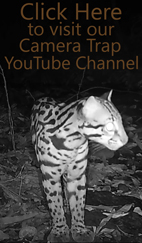
|
|
|
Do not adjust your screen!
Your eyes do not deceive you and NO, this
picture was not doctored! Welcome to the world
of the Giant Marine Toad, Costa Rica's largest
amphibian. A predator nothing short of
extreme.
|
|
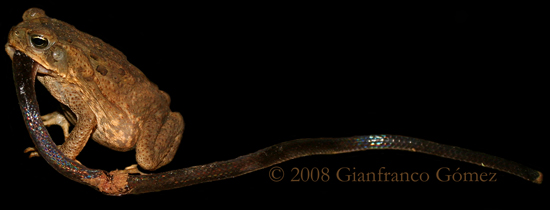
|
|
These
pictures were taken in early December 2006
during a Night Tour. We were wrapping up the
evening when we came across this grizzly
scene. A Marine Toad no larger than 12
centimeters swallowing a 30 centimeter
Sock-headed Snake (Enuliophis
sclateri). As we approached we
startled the toad and he partially
regurgitated the still living, still squirming
snake.
Seconds later, as it grew accustomed to our
incredulous stares, it proceeded to engulf the
helpless snake. The whole process took about
15 excruciating minutes, leaving the toad
bloated to the point of catatonia and
seemingly unable to hop away to save its own
life.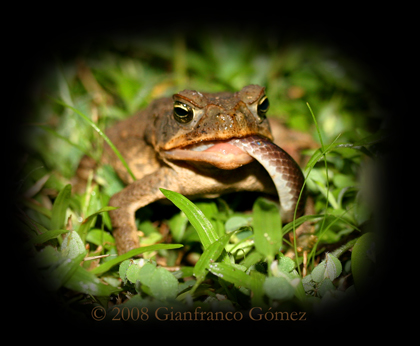
It
just sat there looking as satisfied by his feat
as we were shocked by it.
Giant Marine Toads are, without a doubt,
noteworthy predators. With adult females
reaching weights of 1.5 kilograms and
measuring up to 240 millimeters they are a
menacing presence. Individuals don't get quite
that large in Costa Rica and adult females
normally reach their maximum length at 175
millimeters. Nevertheless, several guests on
the Night Tour have confessed to having
mistaken them for garden ornaments.
Giant Marine Toads are
opportunistic sit-and-wait predators. Prey
items may include insects, spiders, small
frogs and reptiles, mice, rats and pretty much
any other small animal it can stuff into its
mouth. It is in the vicinity of homes with
house pets where you find the very large ones.
Not necessarily because they eat the house
animals, although they have been known to eat
kittens, but because they have learned to feed
on canned and dry pet food. This is a
remarkable accomplishment for the toad because
in nature they don't normally eat inanimate
objects.
|
|
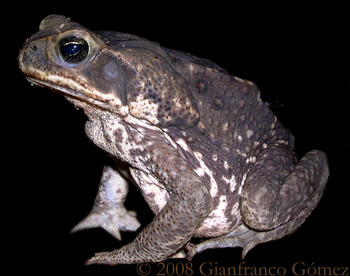 These are the
notorious Cane Toads, reviled the world over
by most of those obliged to share their homes
with them. Although they are native to Costa
Rica, they have been exported throughout the
world and have become a rather cosmopolitan
species. These are the
notorious Cane Toads, reviled the world over
by most of those obliged to share their homes
with them. Although they are native to Costa
Rica, they have been exported throughout the
world and have become a rather cosmopolitan
species.
It is now considered that
Giant Marine Toads have adapted to life
amongst humans and to our disturbed habitats
even better than their natural habitats.
Population samples in some agricultural areas
have been estimated at an astonishing 300
toads per hectare! Meanwhile, scientists
calculate Marine Toad populations living along
forest edges at about 10 toads per hectare and
those living in natural open areas at about 25
toads per hectare.
Although these behemoths are
now widely considered pests this was not
always the case. Giant Marine Toads were
willingly imported by people throughout the
Caribbean Islands and into the Philippines,
Hawaii, New Guinea, Australia and Florida.
This was done in a failed attempt to control
insect pests in sugarcane plantations. Many of
the areas they were imported into left the
toads with no natural predators and
populations exploded. The voracious toads then
proceeded to devour every native species they
could catch. This has seriously depleted
diversity in many areas.
In
Australia it's impact is not only
environmental, but also economical. There,
Giant Marine Toads use waterways to breed and
large numbers of them also die there. Decaying
toads and their toxic eggs contaminate water
sources used by herds of sheep and cattle.
This kills the animals, leaving ranchers to
count their losses.
|
|
 In regions
where they are native, Marine Toads are preyed
upon by a variety of reptiles, birds, and
mammals. They are afforded some protection
from predators by the two large toxin glands
located behind their eyes. When disturbed,
Giant Marine Toads can spray the toxin from
their glands a distance of up to 30
centimeters and a cat or dog could easily die
by simply mouthing it. Rainforest mammals like
Opossums, Raccoons, and Coatis have been
observed flipping the toads over and starting
their meal through the toad's soft stomach,
thereby avoiding the toxins. In regions
where they are native, Marine Toads are preyed
upon by a variety of reptiles, birds, and
mammals. They are afforded some protection
from predators by the two large toxin glands
located behind their eyes. When disturbed,
Giant Marine Toads can spray the toxin from
their glands a distance of up to 30
centimeters and a cat or dog could easily die
by simply mouthing it. Rainforest mammals like
Opossums, Raccoons, and Coatis have been
observed flipping the toads over and starting
their meal through the toad's soft stomach,
thereby avoiding the toxins.
The
toxin is a milky liquid garnished with a
chemical named Bufotenidine. This substance
has been attributed hallucinogenic properties
and is said to have effects similar to LSD.
Some turn to the Marine Toad searching for a
psychedelic trip via toad licking. This
activity should always be avoided. Other
symptoms, apart from the hallucinations, may
include hypertension, constricting blood
vessels, overly powerful heartbeat, and could
culminate in a direct poisoning of the heart
muscle.
|
|
During their mating season
males congregate in breeding areas. These are
usually located near slow moving streams.
Calling males will sit partially submerged at
the edge of the water and call out to the
females. If a male successfully attracts a
female, mating will take place while they are
in the water. 
The female
will lay up to 25,000 eggs as the male releases
a cloud of sperm into the water.
The
eggs are attached to two strings and covered
with toxic jelly. The female toad will wrap
the strings around vegetation growing from the
bottom of the breeding pool to anchor them.
The eggs develop for three to four days days
before hatching and tadpoles will complete
their metamorphosis in sixty to seventy-five
days. After the little toads emerge from the
water, the pace of their growth is tremendous.
Males will reach close to their maximum size
the first year of their lives, while the
larger females will grow for four to five
years. Giant Marine Toads have been known to
live as long as 16 years in captivity.
|
|
References:
Janzen, D. 1983
Costa Rican Natural History University
of Chicago Press
Leenders, T.
2001 A Guide to Amphibians and Reptiles
of Costa Rica Zona Tropical
Savage, J. 2002 The Amphibians and
Reptiles of Costa Rica University
of Chicago Press
|
Click
below for more information about Gian's book

|
|
|
|
The Frog Files





     







|



 Alien
Earthlings
Alien
Earthlings  The Dark Side
The Dark Side






 These are the
notorious Cane Toads, reviled the world over
by most of those obliged to share their homes
with them. Although they are native to Costa
Rica, they have been exported throughout the
world and have become a rather cosmopolitan
species.
These are the
notorious Cane Toads, reviled the world over
by most of those obliged to share their homes
with them. Although they are native to Costa
Rica, they have been exported throughout the
world and have become a rather cosmopolitan
species.  In regions
where they are native, Marine Toads are preyed
upon by a variety of reptiles, birds, and
mammals. They are afforded some protection
from predators by the two large toxin glands
located behind their eyes. When disturbed,
Giant Marine Toads can spray the toxin from
their glands a distance of up to 30
centimeters and a cat or dog could easily die
by simply mouthing it. Rainforest mammals like
Opossums, Raccoons, and Coatis have been
observed flipping the toads over and starting
their meal through the toad's soft stomach,
thereby avoiding the toxins.
In regions
where they are native, Marine Toads are preyed
upon by a variety of reptiles, birds, and
mammals. They are afforded some protection
from predators by the two large toxin glands
located behind their eyes. When disturbed,
Giant Marine Toads can spray the toxin from
their glands a distance of up to 30
centimeters and a cat or dog could easily die
by simply mouthing it. Rainforest mammals like
Opossums, Raccoons, and Coatis have been
observed flipping the toads over and starting
their meal through the toad's soft stomach,
thereby avoiding the toxins. 







